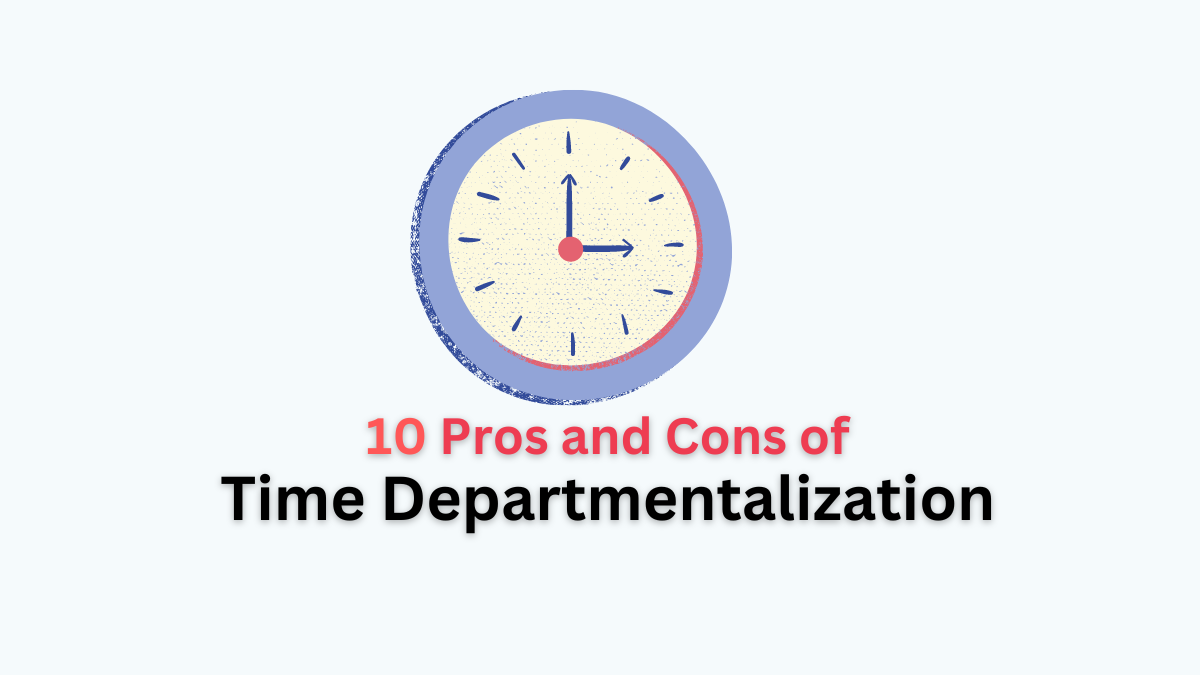Pros and Cons of Time Departmentalization
Time departmentalization is an organizational structure where departments are created based on different work shifts (e.g., day, evening, night), ensuring continuous operations and service provision. This method enhances flexibility, resource utilization, and employee satisfaction while addressing 24-hour operational needs.
Here we will delve into 10 major pros and cons of time departmentalization in the workplace, so let’s get started:
Pros of Time Departmentalization
Below are the five main advantages of departmentalization by time in the workplace:
Enhanced Employee Satisfaction
Time departmentalization offers flexibility in work schedules, allowing employees to choose shifts that best align with their commitments and preferences. This flexibility leads to higher job satisfaction and a better work-life balance.
For instance, employees with family obligations or other personal commitments can opt for shifts that suit their needs, thereby increasing their overall satisfaction and reducing turnover rates.
Improved Customer Service
By operating around the clock, organizations can cater to customer needs at any time of the day, which enhances customer satisfaction. This 24-hour availability means that customers can access services and support whenever they need them, leading to higher customer loyalty and improved service quality.
For example, hospitals and emergency services must be available at all times to provide critical care to patients.
Flexible Operations
Time departmentalization ensures operational flexibility, allowing organizations to adapt to changing demand patterns or unforeseen circumstances quickly. This flexibility helps in optimizing resource utilization and maintaining steady operations even during peak demand periods.
For instance, a call center can adjust its staffing levels based on call volumes at different times of the day, ensuring that customer queries are handled efficiently.
Efficient Resource Utilization
Dividing the workforce into different shifts allows for continuous operations without overburdening employees. This method ensures better utilization of resources, machinery, and facilities throughout the day or night.
For example, manufacturing plants can run their equipment continuously by rotating shifts, thereby maximizing production output and reducing downtime.
Read More: 10 Pros and Cons of Functional Departmentalization
Optimized Performance
The division of labor and shifts facilitates a more focused approach to work.
Employees working within specific shifts tend to be more efficient and productive, as they can concentrate on their tasks without the distractions that might come with a traditional 9-to-5 schedule. This focus on shift-specific tasks leads to increased overall productivity and better performance outcomes.
Cons of Time Departmentalization
Now, let’s explore the five main disadvantages of time departmentalization in the organization:
Coordination Challenges
Managing coordination and communication between different shifts can be a significant challenge. Handovers between shifts might lead to information gaps, impacting the continuity of operations and causing misunderstandings.
For instance, a lack of proper communication during shift changes in a hospital can lead to errors in patient care and treatment.
Read More: 10 Major Pros and Cons of Customer Departmentalization
Duplication of Efforts
There is a risk of duplication of efforts or resources across shifts. If tasks or processes are repeated or handled differently between shifts, it can lead to inefficiencies, wastage, or confusion in the workflow.
For example, different shifts in a production facility might perform the same quality checks independently, resulting in redundant work and wasted resources.
Shift Responsibility
Transferring responsibilities from one shift to another can create a lack of accountability. Issues or problems might be passed between departments, leading to a culture where each shift blames the other for any arising issues. This lack of accountability can undermine overall efficiency and problem-solving within the organization.
Read More: 10 Major Pros and Cons of Process Departmentalization
Communication Barriers
Interdepartmental communication might suffer due to the separation of shifts. Information sharing between different time-based departments may not be as effective, leading to misunderstandings or delays in decision-making.
For instance, in a customer service center, vital information about a customer’s issue might not be effectively communicated across shifts, resulting in poor service.
Limited Efficiency in Interdepartmental Tasks
Projects or tasks that involve multiple departments or shifts may face difficulties due to varying schedules and a lack of synchronous working hours. This can hinder collaboration and slow down project timelines.
For example, a product development team working on a new feature might struggle to coordinate with the quality assurance team if they operate on different shifts, delaying the project’s completion.
In conclusion, time departmentalization offers significant advantages, particularly in industries that require continuous operations. It enhances employee and customer satisfaction, ensures flexible operations, optimizes resource utilization, and boosts performance. However, it also presents challenges such as coordination difficulties, duplication of efforts, shift responsibility issues, communication barriers, and limited efficiency in interdepartmental tasks. Organizations must carefully weigh these pros and cons to determine if time departmentalization aligns with their operational needs and goals.
Read Next: 10 Major Pros and Cons of Job Enrichment in the Workplace
